Samuel Avery

Chancellorship Dates
January 1, 1908 - August 1, 1928
Degrees
- B.A., Doane College, 1887
- B.S., University of Nebraska, 1892
- M.A., University of Nebraska, 1894
- Ph.D., Heidelberg University, 1896
Born
April 19, 1865 - Lamoille, IllinoisDied
January 25, 1936 - Lincoln, NebraskaInterment
Wyuka Cemetery, Lincoln Nebraska, Sec. 22, Lot 107, Space 3Artifacts
Sources
Samuel Avery was a professor of agricultural chemistry at Nebraska when he was tapped to serve as Interim Chancellor after the resignation of E. Benjamin Andrews in January, 1909. The “Interim” was dropped from his title in December of that year, when the Board of Regents officially appointed him chancellor.
Andrews had left Nebraska a truly great university, fifth in enrollment in the United States. For his successor, the Board of Regents would shortly give up on a national search and instead tap Avery to lead the University of Nebraska on a permanent basis.
As Robert Knoll would observe in his history of the university, Prairie University, Avery was "devoted to his university," but "not an intellectual." Despite this, the talent within the faculty was undeniable, and for several years luminaries such as Louise Pound, Hartley Burr Alexander and Charles Bessey would sustain Nebraska's reputation. In 1917, America would enter a World War, led by a Nebraska Law alum, General John J. Pershing, commander of the American Expeditionary Forces. Back at the University, the Regents, bowing to pressure, began investigating faculty, in public hearings, who appeared to be unenthusiastic about the war. Those of German ancestry were especially suspect; the populace was aroused. It was not a good omen for a great university.
Postwar economic conditions were difficult. The agricultural economy on which the state disproportionately depended was hurt by falling commodity prices. Budgets tightened, and in 1923 students were asked to contribute to the support of the university in the form of tuition.
Avery would serve in the office until 1927, returning then to his first love, the chemistry lab and teaching. The Chemistry Laboratory building (today’s Avery hall) was dedicated in 1916.